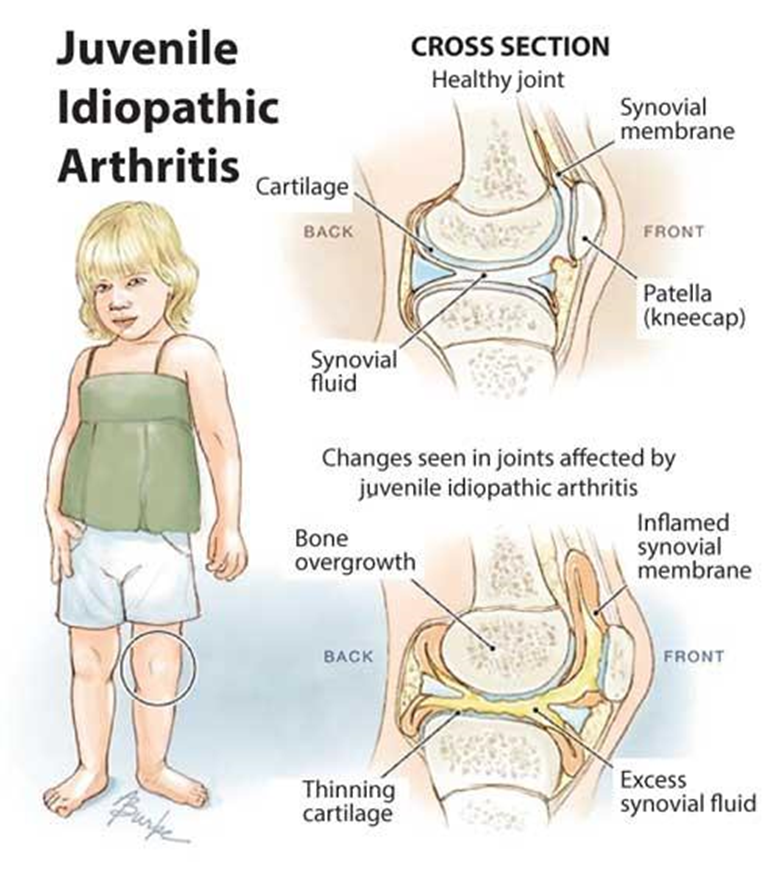A nurse is providing discharge instructions to a parent and his school-age child who has juvenile idiopathic arthritis. Which of the following
instructions should the nurse include?
Encourage the child to take a 45 min nap daily
Administer prednisone on an alternate day schedule
Apply cool compresses for 20 min every hour
Allow the child to stay at home on days when her joints are painful
The Correct Answer is B
Choice A reason: Encouraging the child to take a 45 min nap daily is not a helpful instruction, as it may interfere with the child's normal sleep pattern and school schedule. The child may benefit from regular rest periods throughout the day, but not necessarily a long nap. ⁵
Choice B reason: Administering prednisone on an alternate day schedule is a helpful instruction, as it is a common way of prescribing corticosteroids for children with juvenile idiopathic arthritis. Corticosteroids are used to reduce inflammation and control symptoms, but they have many side effects, such as growth suppression, weight gain, and osteoporosis. Giving the medication every other day may reduce some of these side effects and improve compliance. ⁶

Choice C reason: Applying cool compresses for 20 min every hour is not a helpful instruction, as it may cause skin damage and discomfort. Cool compresses may be useful for acute inflammation, but not for chronic arthritis. Warm compresses or baths may be more soothing and beneficial for the child's joints. ⁷
Choice D reason: Allowing the child to stay at home on days when her joints are painful is not a helpful instruction, as it may lead to social isolation, academic difficulties, and reduced physical activity. The child should be encouraged to attend school and participate in activities as much as possible, with appropriate accommodations and modifications if needed. The child may also benefit from physical therapy, occupational therapy, and pain management strategies. ⁸
Nursing Test Bank
Naxlex Comprehensive Predictor Exams
Related Questions
Correct Answer is D
Explanation
Choice A reason: This is not a correct instruction for the nurse to include in the teaching. The Pavlik harness is a device that holds the infant's hips in a flexed and abducted position to allow the femoral head to fit into the acetabulum. The harness should not be removed by the parents, as this may interfere with the treatment and cause complications. The nurse should instruct the parents to sponge bathe the infant while wearing the harness.
Choice B reason: This is not a correct instruction for the nurse to include in the teaching. The length of the straps of the Pavlik harness should not be adjusted by the parents, as this may affect the alignment and stability of the infant's hips. The nurse should instruct the parents to bring the infant to the provider's office regularly for check-ups and adjustments of the harness.
Choice C reason: This is not a correct instruction for the nurse to include in the teaching. Massaging the infant's skin under the straps of the Pavlik harness may cause irritation, friction, or pressure on the skin, which may lead to skin breakdown or infection. The nurse should instruct the parents to keep the infant's skin clean and dry, and to check for any signs of redness, swelling, or drainage.
Choice D reason: This is a correct instruction for the nurse to include in the teaching. Placing the diaper under the straps of the Pavlik harness prevents the diaper from interfering with the position and function of the harness. The nurse should instruct the parents to change the diaper frequently and to avoid using bulky or cloth diapers.
Correct Answer is C
Explanation
Choice A reason: Promising not to tell anyone about the abuse is not a helpful statement, as it implies that the abuse is a secret that should be hidden. This may make the child feel ashamed, guilty, or isolated. The nurse has a duty to report the abuse to the proper authorities and to protect the child from further harm.
Choice B reason: Blaming the family for the abuse is not a helpful statement, as it may cause the child to feel conflicted, angry, or fearful. The child may still love the family member who abused them, or may depend on them for their basic needs. The nurse should avoid making judgments or accusations, and instead focus on the child's feelings and safety.
Choice C reason: Reassuring the child that the abuse is not their fault is a helpful statement, as it may help the child cope with the trauma and reduce the feelings of self-blame, guilt, or shame. The nurse should validate the child's emotions and let them know that they are not responsible for the abuse or for stopping it.
Choice D reason: Suggesting to discuss the abuse with the family is not a helpful statement, as it may put the child in danger or cause them more distress. The child may not feel comfortable or safe to talk about the abuse with the family member who abused them, or with other family members who may not believe them or support them. The nurse should respect the child's privacy and boundaries, and only involve the family with the child's consent and under professional guidance.
Whether you are a student looking to ace your exams or a practicing nurse seeking to enhance your expertise , our nursing education contents will empower you with the confidence and competence to make a difference in the lives of patients and become a respected leader in the healthcare field.
Visit Naxlex, invest in your future and unlock endless possibilities with our unparalleled nursing education contents today
Report Wrong Answer on the Current Question
Do you disagree with the answer? If yes, what is your expected answer? Explain.
Kindly be descriptive with the issue you are facing.
